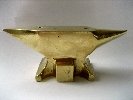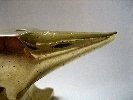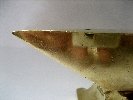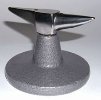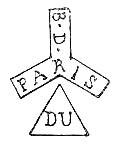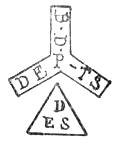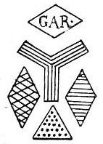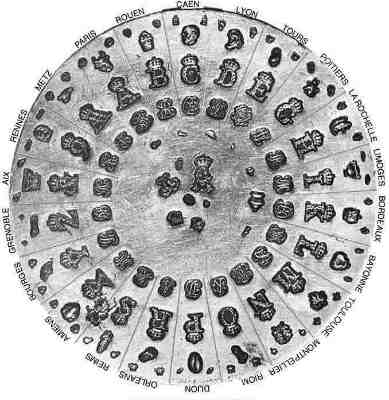 ASSOCIATION OF SMALL COLLECTORS OF ANTIQUE SILVER
ASSOCIATION OF SMALL COLLECTORS OF ANTIQUE SILVERASCAS
|
|
article # 145 |
|
|
|
(click on photos to enlarge image)THE BIGORNE MARK ON FRENCH SILVERINTRODUCTION
|

1717-1722 - large articles |
Etienne de Bourges, Charles Yvon, Armand Pilavoine, Charles Cordier |
|
1722-1727 - large articles |
Charles Cordier, Jacques Cottin |

1727-1732 - medium articles |
Jacques Cottin, Louis Gervais, Hubert Louvet |

1732-1738 - large and medium articles |
Hubert Louvet |
|
1738-1744 - small articles |
Louis Robin, Antoine Leschaudel |

1744-1750 - small articles |
Antoine Leschaudel |

1750-1756 - Boar's head - large articles |
Julien Berthe |

1750-1756 - Hen's head - small articles |
Julien Berthe |

1756-1762 - small articles |
Eloy Brichard |
|
1756-1762 - large articles |
Eloy Brichard |

1762-1768 - Dog's head - small articles |
Jean-Jacques Prévost |

1762-1768 - large articles |
Jean-Jacques Prévost |
|
1768-1774 - medium articles |
Julien Alaterre |
|
1768-1774 - large articles |
Julien Alaterre |
|
1774-1780 - Cow's head - large articles (note 2) |
Jean-Baptiste Fouache, Dominique Compant |

1775-1781 - Monkey's head - small articles |
Jean-Baptiste Fouache, Dominique Compant |
|
1781-1789 - large articles |
Henri Clavel |
|
1781-1789 - medium articles |
Henri Clavel |

1783-1789 - Parrot’s head - medium articles |
Jean-François Calendrin |
|
1785 |
. |

1787 |
. |

1788 |
. |

1789 |
. |
The Tax Farmers (note 3)
acted in the king's name in the collection of duties. They
operated under a six-year contract and often accumulated immense
fortunes which in some cases enabled them to play a significant
political and social role. The Ferme Générale was one of the
institutions of the Ancien Régime which was highly criticized
during the French Revolution until its suppression in 1790
(note 4).
The impact of the Revolution in the way of life of French people
had obvious repercussions also in the organization of trade and
its Guilds (including Goldsmiths). The result was that from 1789
to 1797 no attention was paid to the stamping of plate.
During this eight years any goldsmith or silversmith had the
opportunity to use whatever fineness he wished in his gold and silver
artifacts. In Paris the Association of Gold & Silversmiths tried
to remedy this situation by the introduction of two new punches
with a Greek woman's head. These marks, being a private initiative,
had no value as a legal guarantee.
Note the letter P at the left side of the head for 1793 and
the figure 1 at the right hand side of the head for the period
1794-1797.
The groundwork of the future legislation on the standard and
assay of precious metals was laid by the Act of the 19 Brumaire,
An VI (1797). The act provided an entirely new set of marks:
a rooster for the standard mark with the figure 1 for a fineness
of .950 and a figure 2 for a fineness of .800.
For Paris the figures 1 and 2 appear at the right side of the
rooster and for the Provinces at the left side.
The maker's mark was a lozenge with the initials of the silversmith's name
and a symbol.
BIGORNE
In order to prevent and detect fraud of hallmarked silver
articles, French authorities instituted, by Ordinance of 1st July
1818, a system of countermarks on the opposite side of the
guarantee mark. These countermarks are known as "bigornes".
The term bigorne literally means two-horned anvil or two-beaked
anvil and refers to the shape of the projecting ends of the
anvil. Each anvil has two striking areas, one flat and one of
rounded shape. The rounded horn served to mark hollowware and
the flat horn was used to mark flatware.
The projecting ends of the small anvil were intricately
engraved with varied and finely drawn representations of insects.
The silver article was placed on the beak/horn of the steel
anvil and when the guarantee mark was struck, the force of the
strike created a counter-impression of insects on the underside
of the article against the anvil.
BIGORNES INTRODUCED BY ORDINANCE OF 1ST JULY 1818 AND USED FROM
AUGUST 1819 TILL MAY 1838
There are three sizes of bigorne marks, having randomly arranged
insects on a plain background, except for the small bigorne
which had both a rounded and a flat end.
1. The large bigorne with a horn on which the six different
insects are engraved inside various frames (triangle, pentagon,
indented parallelogram, lozenge, etc).
2. The medium-sized bigorne with a horn bearing engraved insects,
but not so many as on the large bigorne. Both bigornes are the
same for Paris as for the Provinces.
3. The small bigorne with two horns, one flat and the other rounded, bearing engraved triangles and lozenges with linear designs and letters.
BIGORNES INSTITUTED BY A DECREE OF 30th JUNE 1835, PUT IN
USE ON 9th MAY 1838 (MODIFIED IN DECEMBER 1846)
This system is even more sophisticated than the preceding one,
because the insects are engraved aligned in relief and separated
by parallel zigzag moulded borders. This series was further
distinguished by having one set for Paris and another set for
the Provinces.
The surface of the anvil is covered with varied and finely drawn
engravings of various insects which mark the underside of the
silver article when it is struck on the upper side with the
guarantee mark. The assayer placed the item on the horn of the
anvil, then placed the Minerva (or other) punch on the item, and
struck the Minerva punch with a mallet. Through the force of
the strike both marks were created simultaneously. For this
reason a bigorne mark will be found opposite the guarantee mark.
The bigorne dies are so complex that two similar strikes could
not be obtained.
There are three types of bigorne used according the object size:
large (16 bands), medium (13 bands) and small (21 bands). The
rounded horn and the flat horn are used depending on the shape
of the article to be marked.
For Paris the insects are shown in profile:
For the Provinces (Départements) the insects are presented in bird's eye view
The borders separating the bands of insects are hollow
except on the medium sized bigorne and on the rounded horn of
the small bigorne. In these cases the tiny grooves are covered
with dots; these serve as a support in the marking of very thin
articles and also prevent the marks to appear only on the
surfaces resting on the insects.
The Article 185 of Appendix III of the French General Tax Code (which
introduced the insect-engraved bigornes in use from 1838) was
officially abrogated on 16 July 1984 by the Article 9 of Decree
No. 84-623.
SOURCES
www.douane.gouv.fr
http://www.silvercollection.it/frenchhallmarks.html
http://www.silvercollection.it/frenchhallmarksold.html
International Hallmarks on Silver collected by Tardy, 2005
reprint
Les fermiers généraux au XVIIIe siècle, Paris, Maisonneuve et
Larose by Yves Durand
ENDNOTES
note 1 Minister of Finance to the King Louis XIV
note 2 Plate with the hallmarks used by the local
government control of the tax farmer (Fermier Général) J.B.
Fouache
note 3 Tax farmers were obliged to pay to the
Royal Treasury the sum stipulated in their lease, and received a
share of the income and a share of any unexpected surplus
note 4 28 former Fermiers Généraux were guillotined on 8
May 1794
Robert Massart
|

















